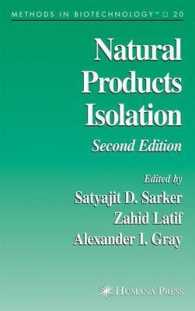Full Description
The tenth edition of Mathematics for Elementary Teachers: A Conceptual Approach continues the innovative time-tested approach of the previous editions: an emphasis on learning via specific, realistic examples and the extensive use of visual aids, hands-on activities, problem-solving strategies and active classroom participation. Features of the text focus on ensuring that prospective teachers will gain not only a deeper understanding of the mathematical concepts, but also a better sense of the connections between their college math courses and their future teaching experiences, along with helpful ideas for presenting math to their students in a way that will generate interest and enthusiasm. The text draws heavily on Common Core Standards and contains many pedagogical elements designed to foster reasoning, problem-solving and communication skills.
Additionally, this text can be packaged with an activity set that corresponds to each section of the companion text, Mathematics for Elementary Teachers: An Activity Approach, also by the Bennett, Burton, and Nelson team. Mathematics for Elementary Teachers: An Activity Approach can be used independently or along with its companion, Mathematics for Elementary Teachers: A Conceptual Approach.
Contents
Chapter 1: Problem Solving 1.1 Introduction to Problem Solving 1.2 Patterns and Problem Solving Chapter 2: Sets and Reasoning 2.1 Sets and Venn Diagrams 2.2 Introduction to Deductive Reasoning Chapter 3: Whole Numbers 3.1 Numeration Systems 3.2 Addition and Subtraction 3.3 Multiplication 3.4 Division and Exponents Chapter 4: Number Theory4.1 Factors and Multiples4.2 Greatest Common Factor and Least Common Multiple Chapter 5: Integers and Fractions5.1 Integers5.2 Introduction to Fractions 5.3 Operations with Fractions Chapter 6: Decimals: Rational and Irrational Numbers6.1 Decimals and Rational Numbers 6.2 Operations with Decimals 6.3 Ratio, Percent, and Scientific Notation 6.4 Irrational and Real Numbers Chapter 7: Statistics 7.1 Collecting and Graphing Data 7.2 Describing and Analyzing Data 7.3 Sampling, Predictions, and Simulations Chapter 8: Probability and Counting8.1 Single-Stage Experiments 8.2 Multistage Experiments 8.3 Counting, Permutations, and Combinations Chapter 9: Algebra9.1 Problem Solving with Algebra9.2 Coordinates, Slope, and Lines9.3 Functions and Graphs Chapter 10: Geometric Figures10.1 Plane Figures 10.2 Polygons and Tessellations 10.3 Space Figures 10.4 Symmetric Figures Chapter 11: Measurement 10.1 Systems of Measurement11.2 Area and Perimeter 11.3 Volume and Surface Area Chapter 12: Transformations: Constructions, Congruence and Similarity Mapping12.1 Congruence and Constructions 12.2 Congruence Mappings 12.3 Similarity Mappings







